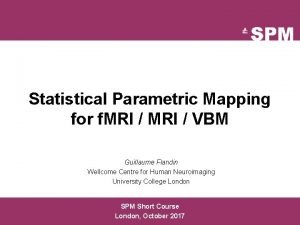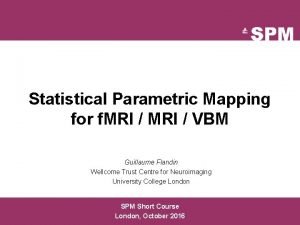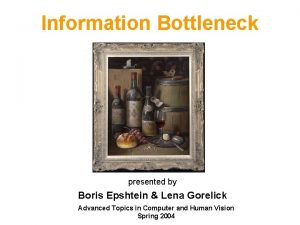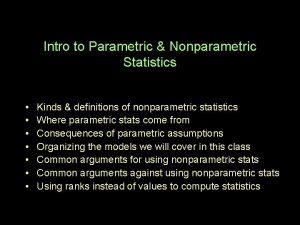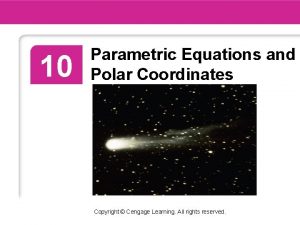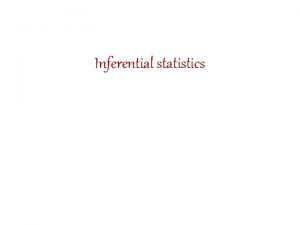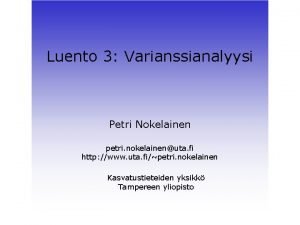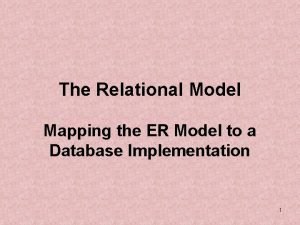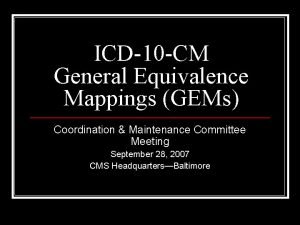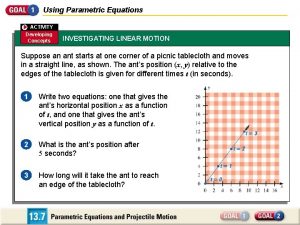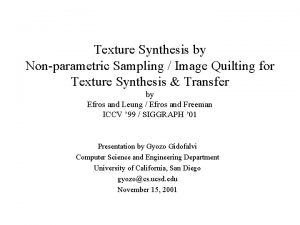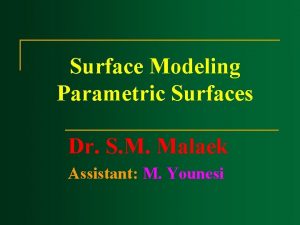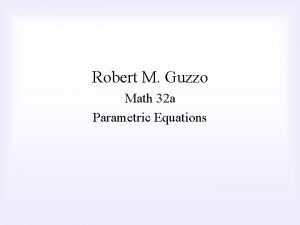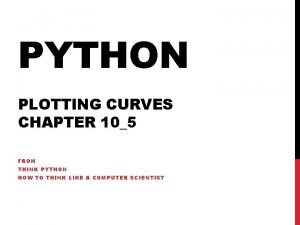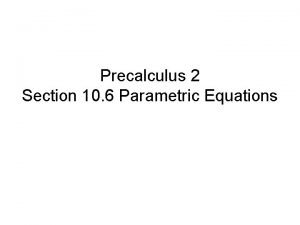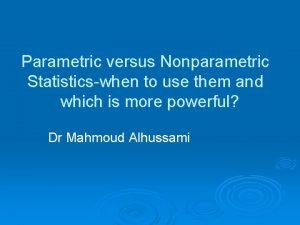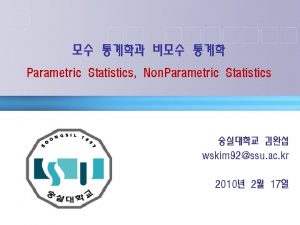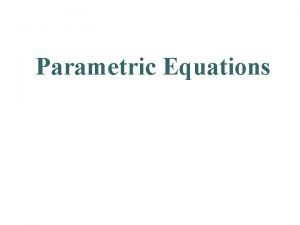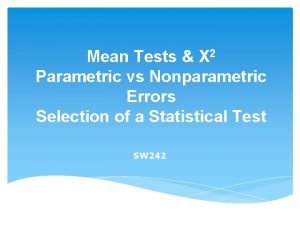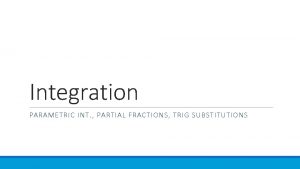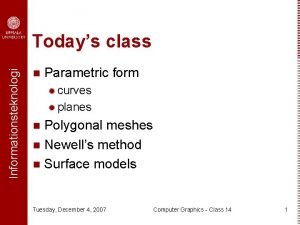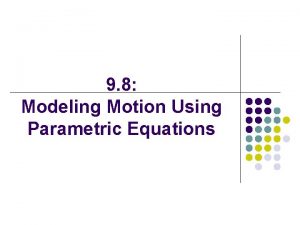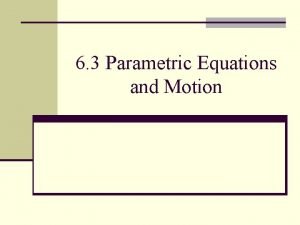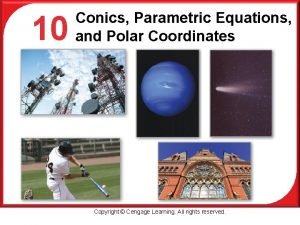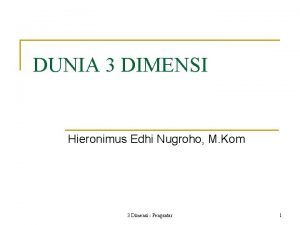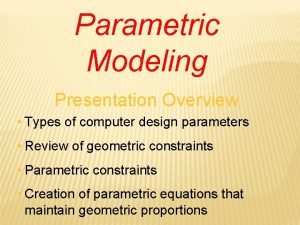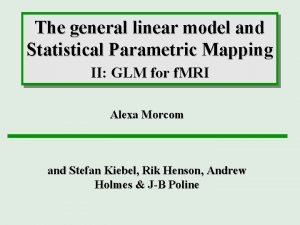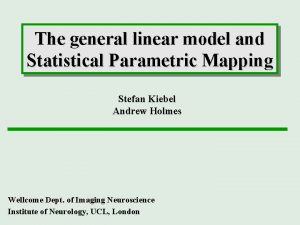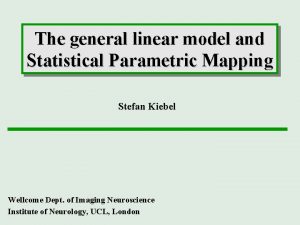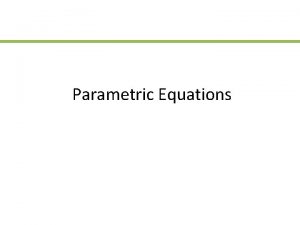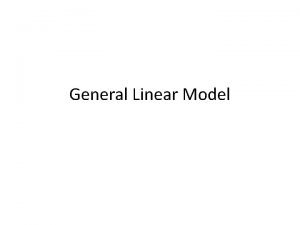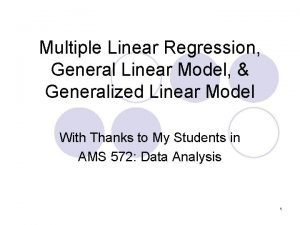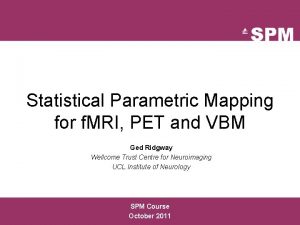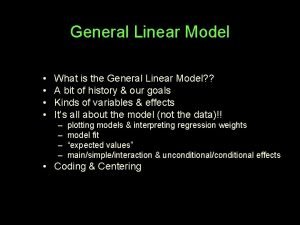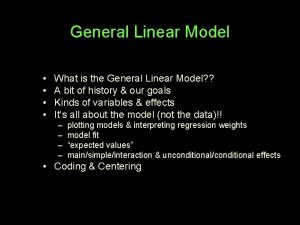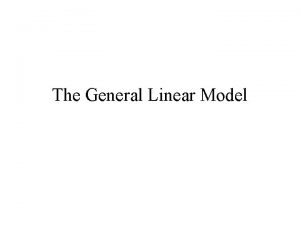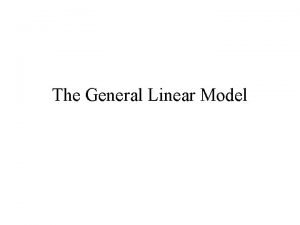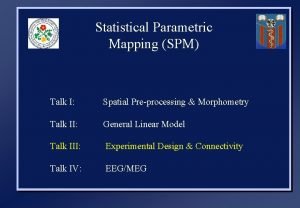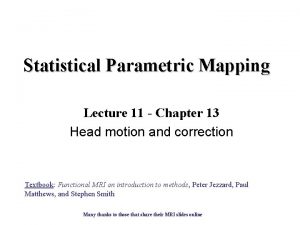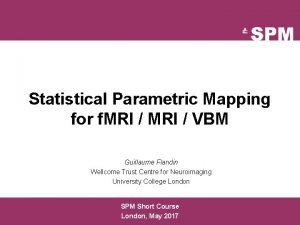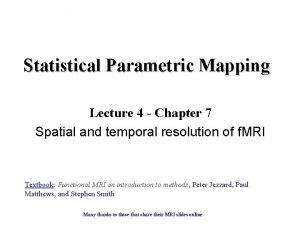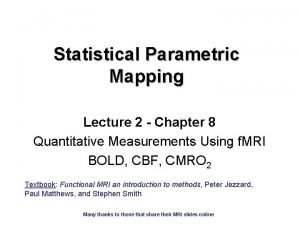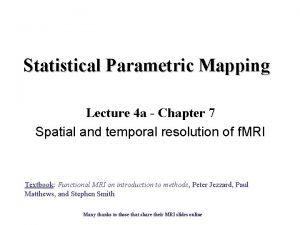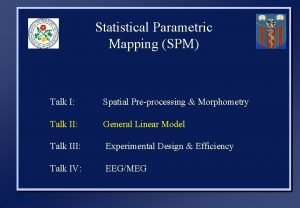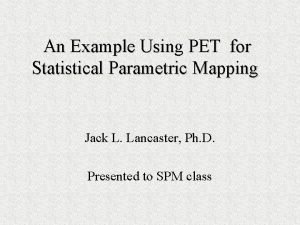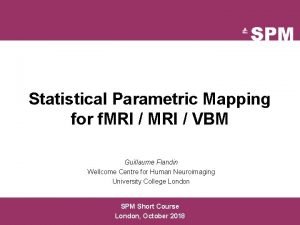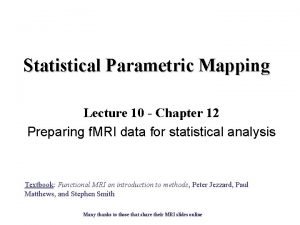The general linear model and Statistical Parametric Mapping



































- Slides: 35

The general linear model and Statistical Parametric Mapping I: Introduction to the GLM Alexa Morcom and Stefan Kiebel, Rik Henson, Andrew Holmes & J-B Poline

Overview • Introduction • Essential concepts – Modelling – Design matrix – Parameter estimates – Simple contrasts • Summary

Some terminology • SPM is based on a mass univariate approach that fits a model at each voxel – Is there an effect at location X? Investigate localisation of function or functional specialisation – How does region X interact with Y and Z? Investigate behaviour of networks or functional integration • A General(ised) Linear Model – Effects are linear and additive – If errors are normal (Gaussian), General (SPM 99) – If errors are not normal, Generalised (SPM 2)

Classical statistics. . . • Parametric – – – – – one sample t-test two sample t-test paired t-test ANOVA ANCOVA correlation linear regression multiple regression F-tests etc… all cases of the (univariate) General Linear Model Or, with non-normal errors, the Generalised Linear Model

Classical statistics. . . • Parametric – – – – – one sample t-test two sample t-test paired t-test ANOVA ANCOVA correlation linear regression multiple regression F-tests etc… all cases of the (univariate) General Linear Model Or, with non-normal errors, the Generalised Linear Model

Classical statistics. . . • Parametric – – – – – one sample t-test two sample t-test paired t-test ANOVA ANCOVA correlation linear regression multiple regression F-tests etc… • Multivariate? all cases of the (univariate) General Linear Model Or, with non-normal errors, the Generalised Linear Model PCA/ SVD, MLM

Classical statistics. . . • Parametric – – – – – one sample t-test two sample t-test paired t-test ANOVA ANCOVA correlation linear regression multiple regression F-tests etc… • Multivariate? • Non-parametric? all cases of the (univariate) General Linear Model Or, with non-normal errors, the Generalised Linear Model PCA/ SVD, MLM Sn. PM

Why modelling? Why? How? Make inferences about effects of interest 1. 2. Decompose data into effects and error Form statistic using estimates of effects and error Model? Use any available knowledge effects estimate data model statistic error estimate

Choose your model “All models are wrong, but some are useful” George E. P. Box A very general model Variance Bias No normalisation No smoothing Massive model default SPM Lots of normalisation Lots of smoothing Sparse model Captures signal High sensitivity but. . . not much sensitivity but. . . may miss signal

Modelling with SPM Functional data Design matrix Contrasts Smoothed normalised data Preprocessing Templates Generalised linear model Variance components Parameter estimates SPMs Thresholding

Modelling with SPM Design matrix Contrasts Preprocessed data: single voxel Generalised linear model Variance components Parameter estimates SPMs

f. MRI example One session Time series of BOLD responses in one voxel Passive word listening versus rest 7 cycles of rest and listening Each epoch 6 scans with 7 sec TR Question: Is there a change in the BOLD response between listening and rest? Stimulus function

GLM essentials • The model – Design matrix: Effects of interest – Design matrix: Confounds (aka effects of no interest) – Residuals (error measures of the whole model) • Estimate effects and error for data – Parameter estimates (aka betas) – Quantify specific effects using contrasts of parameter estimates • Statistic – Compare estimated effects – the contrasts – with appropriate error measures – Are the effects surprisingly large?

GLM essentials • The model – Design matrix: Effects of interest – Design matrix: Confounds (aka effects of no interest) – Residuals (error measures of the whole model) • Estimate effects and error for data – Parameter estimates (aka betas) – Quantify specific effects using contrasts of parameter estimates • Statistic – Compare estimated effects – the contrasts – with appropriate error measures – Are the effects surprisingly large?

Regression model Intensity + b 2 x 1 Question: Is there a change in the BOLD response between listening and rest? + x 2 error Time = b 1 General case e~N(0, 2 I) (error is normal and independently and identically distributed) e Hypothesis test: b 1 = 0? (using t-statistic)

Regression model = + General case + Model is specified by 1. Design matrix X 2. Assumptions about e

Matrix formulation Yi = b 1 xi + b 2 + ei i = 1, 2, 3 Y 1 = b 1 x 1 + b 2 × 1 + e 1 Y 2 = b 1 x 2 + b 2 × 1 + e 2 Y 3 = b 1 x 3 + b 2 × 1 + e 3 dummy variables Y 1 x 1 1 Y 2 = x 2 1 Y 3 x 3 1 b 1 Y = b+ e X e 1 + e 2 b 1 e 3

Matrix formulation ^ = Hats estimates Linear regression Yi = b 1 xi + b 2 + ei i = 1, 2, 3 Y 1 = b 1 x 1 + b 2 × 1 + e 1 Y 2 = b 1 x 2 + b 2 × 1 + e 2 Yi y 1 ^ b 2 Y 3 = b 1 x 3 + b 2 × 1 + e 3 b 1 Y = b+ e X e 1 + e 2 b 1 e 3 1 ^ Yi x dummy variables Y 1 x 1 1 Y 2 = x 2 1 Y 3 x 3 1 ^ b Fitted values ^ &b ^ b 1 2 ^ ^ &Y Y Residuals e^1 & ^e 2 Parameter estimates 1 2

Geometrical perspective Y 1 x 1 1 Y 2 = x 2 1 Y 3 x 3 1 b 1 e 1 + e 2 b 2 e 3 DATA (Y 1, Y 2, Y 3) Y Y = b 1 X 1 + b 2 X 2 + e X 1 (x 1, x 2, x 3) O (1, 1, 1) X 2 design space

GLM essentials • The model – Design matrix: Effects of interest – Design matrix: Confounds (aka effects of no interest) – Residuals (error measures of the whole model) • Estimate effects and error for data – Parameter estimates (aka betas) – Quantify specific effects using contrasts of parameter estimates • Statistic – Compare estimated effects – the contrasts – with appropriate error measures – Are the effects surprisingly large?

Parameter estimation Ordinary least squares residuals Parameter estimates Estimate parameters such that minimal Least squares parameter estimate

Parameter estimation Parameter estimates Ordinary least squares residuals = r Error variance 2 = (sum of) squared residuals standardised for df = r. Tr / df (sum of squares) …where degrees of freedom df (assuming iid): = N - rank(X) (=N-P if X full rank)

Estimation (geometrical) Y 1 x 1 1 Y 2 = x 2 1 Y 3 x 3 1 b 1 e 1 + e 2 b 2 e 3 DATA (Y 1, Y 2, Y 3) Y RESIDUALS ^ e = (e^1, e^2, e^3)T Y = b 1 X 1 + b 2 X 2 + e X 1 (x 1, x 2, x 3) O ^ Y (1, 1, 1) X 2 design space ^ ^ , Y (Y 1 2 3)

GLM essentials • The model – Design matrix: Effects of interest – Design matrix: Confounds (aka effects of no interest) – Residuals (error measures of the whole model) • Estimate effects and error for data – Parameter estimates (aka betas) – Quantify specific effects using contrasts of parameter estimates • Statistic – Compare estimated effects – the contrasts – with appropriate error measures – Are the effects surprisingly large?

Inference - contrasts A contrast = a linear combination of parameters: c´ x b spm_con*img t-test: one-dimensional contrast, difference in means/ difference from zero boxcar parameter > 0 ? Null hypothesis: à spm. T_000*. img SPM{t} map F-test: tests multiple linear hypotheses – does subset of model account for significant variance Does boxcar parameter model anything? Null hypothesis: variance of tested effects = error variance à ess_000*. img SPM{F} map

t-statistic - example Contrast of parameter estimates c=100000 X Variance estimate Standard error of contrast depends on the design, and is larger with greater residual error and ‚greater‘ covariance/ autocorrelation Degrees of freedom d. f. then = n-p, where n observations, p parameters Tests for a directional difference in means

F-statistic - example Do movement parameters (or other confounds) account for anything? H 0: True model is X 0 H 0: b 3 -9 = (0 0 0 0. . . ) X 0 X 1 (b 3 -9) This model ? test H 0 : c´ x b = 0 ? X 0 Or this one ? Null hypothesis H 0: That all these betas b 3 -9 are zero, i. e. that no linear combination of the effects accounts for significant variance This is a non-directional test

F-statistic - example Do movement parameters (or other confounds) account for anything? H 0: True model is X 0 H 0: b 3 -9 = (0 0 0 0. . . ) X 0 X 1 (b 3 -9) X 0 c’ = This model ? Or this one ? test H 0 : c´ x b = 0 ? 00100000 000100001000 00000100 00000010 00000001 SPM{F}

Summary so far • The essential model contains – Effects of interest • A better model? – A better model (within reason) means smaller residual variance and more significant statistics – Capturing the signal – later – Add confounds/ effects of no interest – Example of movement parameters in f. MRI – A further example (mainly relevant to PET)…

Example PET experiment b 2 b 3 b 4 rank(X)=3 b 1 12 scans, 3 conditions (1 -way ANOVA) yj = x 1 j b 1 + x 2 j b 2 + x 3 j b 3 + x 4 j b 4 + ej where (dummy) variables: x 1 j = [0, 1] = condition A (first 4 scans) x 2 j = [0, 1] = condition B (second 4 scans) x 3 j = [0, 1] = condition C (third 4 scans) x 4 j = [1] = grand mean (session constant)

Global effects • May be variation in PET tracer dose from scan to scan • Such “global” changes in image intensity (g. CBF) confound local / regional (r. CBF) changes of experiment • Adjust for global effects by: - An. Cova (Additive Model) - PET? - Proportional Scaling - f. MRI? • Can improve statistics when orthogonal to effects of interest… • …but can also worsen when effects of interest correlated with global x x xo x x o oo x o o o global o o x An. Cova x x o o global Scaling x xo o o x o o global

Global effects (An. Cova) b 2 b 3 b 4 b 5 rank(X)=4 b 1 12 scans, 3 conditions, 1 confounding covariate yj = x 1 j b 1 + x 2 j b 2 + x 3 j b 3 + x 4 j b 4 + x 5 j b 5 + ej where (dummy) variables: x 1 j = [0, 1] = condition A (first 4 scans) x 2 j = [0, 1] = condition B (second 4 scans) x 3 j = [0, 1] = condition C (third 4 scans) x 4 j = [1] = grand mean (session constant) x 5 j = global signal (mean over all voxels)

Global effects (An. Cova) b 3 b 4 b 1 • Global effects not accounted for • Maximum degrees of freedom (global uses one) b 2 b 3 b 4 b 5 rank(X)=4 b 2 rank(X)=3 b 1 Orthogonal global • Global effects independent of effects of interest • Smaller residual variance • Larger T statistic • More significant Correlated global b 1 b 2 b 3 b 4 b 5 rank(X)=4 No Global • Global effects correlated with effects of interest • Smaller effect &/or larger residuals • Smaller T statistic • Less significant

Global effects (scaling) • Two types of scaling: Grand Mean scaling and Global scaling - Grand Mean scaling is automatic, global scaling is optional - Grand Mean scales by 100/mean over all voxels and ALL scans (i. e, single number per session) - Global scaling scales by 100/mean over all voxels for EACH scan (i. e, a different scaling factor every scan) • Problem with global scaling is that TRUE global is not (normally) known… … only estimated by the mean over voxels - So if there is a large signal change over many voxels, the global estimate will be confounded by local changes - This can produce artifactual deactivations in other regions after global scaling • Since most sources of global variability in f. MRI are low frequency (drift), high-pass filtering may be sufficient, and many people do not use global scaling

Summary • General(ised) linear model partitions data into – Effects of interest & confounds/ effects of no interest – Error • Least squares estimation – Minimises difference between model & data – To do this, assumptions made about errors – more later • Inference at every voxel – Test hypothesis using contrast – more later – Inference can be Bayesian as well as classical • Next: Applying the GLM to f. MRI
 Statistical parametric mapping software
Statistical parametric mapping software Statistical parametric mapping software
Statistical parametric mapping software Parametric test and non parametric test
Parametric test and non parametric test Wilcoxon test effect size
Wilcoxon test effect size Boris epshtein
Boris epshtein Parametric
Parametric Memory parameters
Memory parameters Forward mapping vs backward mapping
Forward mapping vs backward mapping Terjemahan
Terjemahan Polar curve
Polar curve Types of statistics
Types of statistics Chapter 7 conic sections and parametric equations
Chapter 7 conic sections and parametric equations Minitab general linear model
Minitab general linear model Kovariaatit
Kovariaatit Mapping of er model to relational model
Mapping of er model to relational model General equivalence mappings
General equivalence mappings Gmt mapping
Gmt mapping Parametric equations activity
Parametric equations activity Texture synthesis by non-parametric sampling
Texture synthesis by non-parametric sampling Surface modelling in cad
Surface modelling in cad Parametric equations word problems
Parametric equations word problems Matplotlib example plot
Matplotlib example plot Parametric equation of a line
Parametric equation of a line Cramers v interpretation
Cramers v interpretation Wskim
Wskim Parametric insurance nat cat
Parametric insurance nat cat Parametric to cartesian calculator
Parametric to cartesian calculator Parametric vs nonparametric test
Parametric vs nonparametric test Parametric integration
Parametric integration Equation of ellipse in parametric form
Equation of ellipse in parametric form Vertical velocity
Vertical velocity Parametric equations of motion
Parametric equations of motion Cycloid parametric equation
Cycloid parametric equation Mesh dengan surface segi-empat disimpansebagai
Mesh dengan surface segi-empat disimpansebagai Parametric design ppt
Parametric design ppt How to solve parametric equations
How to solve parametric equations
